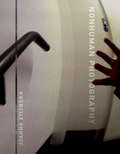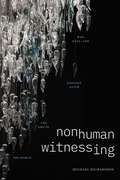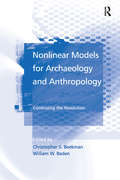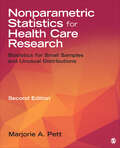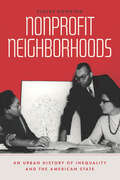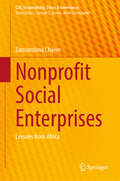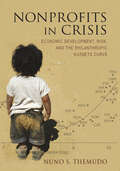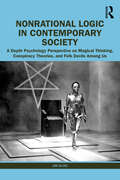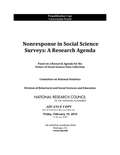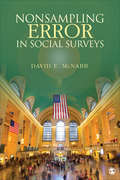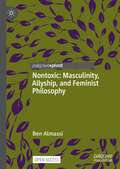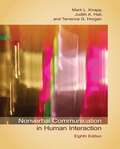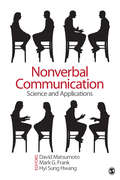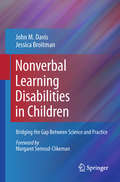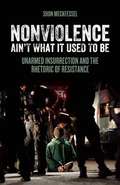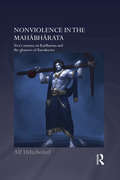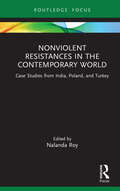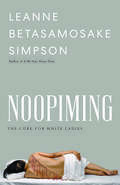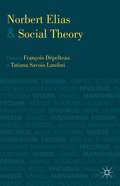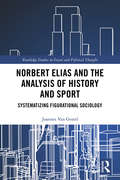- Table View
- List View
Nonhuman Photography (The\mit Press Ser.)
by Joanna ZylinskaA new philosophy of photography that goes beyond humanist concepts to consider imaging practices from which the human is absent, as both subject and agent.Today, in the age of CCTV, drones, medical body scans, and satellite images, photography is increasingly decoupled from human agency and human vision. In Nonhuman Photography, Joanna Zylinska offers a new philosophy of photography, going beyond the human-centric view to consider imaging practices from which the human is absent. Zylinska argues further that even those images produced by humans, whether artists or amateurs, entail a nonhuman, mechanical element—that is, they involve the execution of technical and cultural algorithms that shape our image-making devices as well as our viewing practices. At the same time, she notes, photography is increasingly mobilized to document the precariousness of the human habitat and tasked with helping us imagine a better tomorrow. With its conjoined human-nonhuman agency and vision, Zylinska claims, photography functions as both a form of control and a life-shaping force.Zylinska explores the potential of photography for developing new modes of seeing and imagining, and presents images from her own photographic project, Active Perceptual Systems. She also examines the challenges posed by digitization to established notions of art, culture, and the media. In connecting biological extinction and technical obsolescence, and discussing the parallels between photography and fossilization, she proposes to understand photography as a light-induced process of fossilization across media and across time scales.
Nonhuman Witnessing: War, Data, and Ecology after the End of the World (Thought in the Act)
by Michael RichardsonIn Nonhuman Witnessing Michael Richardson argues that a radical rethinking of what counts as witnessing is central to building frameworks for justice in an era of endless war, ecological catastrophe, and technological capture. Dismantling the primacy and notion of traditional human-based forms of witnessing, Richardson shows how ecological, machinic, and algorithmic forms of witnessing can help us better understand contemporary crises. He examines the media-specificity of nonhuman witnessing across an array of sites, from nuclear testing on First Nations land and autonomous drone warfare to deepfakes, artificial intelligence, and algorithmic investigative tools. Throughout, he illuminates the ethical and political implications of witnessing in an age of profound instability. By challenging readers to rethink their understanding of witnessing, testimony, and trauma in the context of interconnected crises, Richardson reveals the complex entanglements between witnessing and violence and the human and the nonhuman.
Nonlinear Models for Archaeology and Anthropology: Continuing the Revolution
by William W. BadenThe dominant social theory used by archaeologists has tended to focus on either small scale agency or large-scale cultural patterns and processes of change. The authors of this volume argue that archaeologists should use nonlinear models to more accurately model the connections between scales of analysis, and show how micro-scale variation can lead to macro-scale cultural change. This work examines the applications of nonlinear systems models within archaeology and evaluates the range of approaches currently encompassed within Complexity Theory.
Nonparametric Statistics for Health Care Research: Statistics for Small Samples and Unusual Distributions
by Marjorie Marg PettWhat do you do when you realize that the data set from the study that you have just completed violates the sample size or other requirements needed to apply parametric statistics? Nonparametric Statistics for Health Care Research by Marjorie A. Pett was developed for such scenarios—research undertaken with limited funds, often using a small sample size, with the primary objective of improving client care and obtaining better client outcomes. Covering the most commonly used nonparametric statistical techniques available in statistical packages and on open-resource statistical websites, this well-organized and accessible Second Edition helps readers, including those beyond the health sciences field, to understand when to use a particular nonparametric statistic, how to generate and interpret the resulting computer printouts, and how to present the results in table and text format.
Nonparametric Statistics for Health Care Research: Statistics for Small Samples and Unusual Distributions
by Marjorie Marg PettWhat do you do when you realize that the data set from the study that you have just completed violates the sample size or other requirements needed to apply parametric statistics? Nonparametric Statistics for Health Care Research by Marjorie A. Pett was developed for such scenarios—research undertaken with limited funds, often using a small sample size, with the primary objective of improving client care and obtaining better client outcomes. Covering the most commonly used nonparametric statistical techniques available in statistical packages and on open-resource statistical websites, this well-organized and accessible Second Edition helps readers, including those beyond the health sciences field, to understand when to use a particular nonparametric statistic, how to generate and interpret the resulting computer printouts, and how to present the results in table and text format.
Nonpartisan Primary Election Reform
by R. Michael Alvarez J. Andrew SinclairOver the years, observers of American politics have noted the deleterious effects of party polarization in both the national and state legislatures. Reformers have tried to address this problem by changing primary election laws. A theory underlies these legal changes: the reformers tend to believe that "more open" primary laws will produce more centrist, moderate, or pragmatic candidates. The "top-two" primary, just implemented in California, represents the future of these antiparty efforts. Mitigating Mischief examines California's first use of the top-two primary system in 2012. R. Michael Alvarez and Andrew Sinclair evaluate the primary from a variety of perspectives and using several different methodologies. Although the first use of this primary system in California did not immediately reshape the state's politics, it also did not have many of the deleterious consequences that some observers had feared. This study provides the foundation for future studies of state primary systems.
Nonprofit Law: A Practical Guide to Legal Issues for Nonprofit Organizations
by William L. BoydThis book provides lawyers who represent nonprofit organizations with basic information and guidance on legal issues that commonly arise for nonprofits. It provides an overview of the law with regard to particular issues with limited statutory and regulatory citations. This resource covers the formation, tax, governance, and documentation, as well as other areas including mergers and sale of assets of nonprofits, and dissolution of nonprofits. For lawyers who need a quick reference, this guide: - Reviews some basic questions an attorney should ask a client when advising on nonprofit issues, whether the attorney is asked to help form a new nonprofit corporation or advise on some other nonprofit matter- Addresses issues relating to formation and describes important documents that are part of the formation process, including articles of incorporation and bylaws- Discusses taxation issues with a focus on the types of federal tax exemptions that are available under the Internal Revenue Code- Addresses governance matters and describes the individuals involved in the governance of a nonprofit corporation as well as the fiduciary duties imposed on the board of directors- Focuses on other matters that often arise in representation of a nonprofit and includes discussion on subsidiaries of nonprofits, the merger, sale of assets and other entity combinations involving nonprofits, and dissolution of nonprofits- And much more The appendices include a checklist for articles of incorporation and bylaws, a list of tax exemptions under the Internal Revenue Code, as well as resource materials that can provide more detailed information on the subject matter.
Nonprofit Neighborhoods: An Urban History of Inequality and the American State (Historical Studies of Urban America)
by Claire DunningAn exploration of how and why American city governments delegated the responsibility for solving urban inequality to the nonprofit sector. Nonprofits serving a range of municipal and cultural needs are now so ubiquitous in US cities, it can be difficult to envision a time when they were more limited in number, size, and influence. Turning back the clock, however, uncovers both an illuminating story of how the nonprofit sector became such a dominant force in American society, as well as a troubling one of why this growth occurred alongside persistent poverty and widening inequality. Claire Dunning’s book connects these two stories in histories of race, democracy, and capitalism, revealing how the federal government funded and deputized nonprofits to help individuals in need, and in so doing avoided addressing the structural inequities that necessitated such action in the first place. Nonprofit Neighborhoods begins after World War II, when suburbanization, segregation, and deindustrialization inaugurated an era of urban policymaking that applied private solutions to public problems. Dunning introduces readers to the activists, corporate executives, and politicians who advocated addressing poverty and racial exclusion through local organizations, while also raising provocative questions about the politics and possibilities of social change. The lessons of Nonprofit Neighborhoods exceed the bounds of Boston, where the story unfolds, providing a timely history of the shift from urban crisis to urban renaissance for anyone concerned about American inequality—past, present, or future.
Nonprofit Neighborhoods: An Urban History of Inequality and the American State (Historical Studies of Urban America)
by Claire DunningAn exploration of how and why American city governments delegated the responsibility for solving urban inequality to the nonprofit sector. Nonprofits serving a range of municipal and cultural needs are now so ubiquitous in US cities, it can be difficult to envision a time when they were more limited in number, size, and influence. Turning back the clock, however, uncovers both an illuminating story of how the nonprofit sector became such a dominant force in American society, as well as a troubling one of why this growth occurred alongside persistent poverty and widening inequality. Claire Dunning’s book connects these two stories in histories of race, democracy, and capitalism, revealing how the federal government funded and deputized nonprofits to help individuals in need, and in so doing avoided addressing the structural inequities that necessitated such action in the first place. Nonprofit Neighborhoods begins after World War II, when suburbanization, segregation, and deindustrialization inaugurated an era of urban policymaking that applied private solutions to public problems. Dunning introduces readers to the activists, corporate executives, and politicians who advocated addressing poverty and racial exclusion through local organizations, while also raising provocative questions about the politics and possibilities of social change. The lessons of Nonprofit Neighborhoods exceed the bounds of Boston, where the story unfolds, providing a timely history of the shift from urban crisis to urban renaissance for anyone concerned about American inequality—past, present, or future.
Nonprofit Neighborhoods: An Urban History of Inequality and the American State (Historical Studies of Urban America)
by Claire DunningAn exploration of how and why American city governments delegated the responsibility for solving urban inequality to the nonprofit sector. Nonprofits serving a range of municipal and cultural needs are now so ubiquitous in US cities, it can be difficult to envision a time when they were more limited in number, size, and influence. Turning back the clock, however, uncovers both an illuminating story of how the nonprofit sector became such a dominant force in American society, as well as a troubling one of why this growth occurred alongside persistent poverty and widening inequality. Claire Dunning’s book connects these two stories in histories of race, democracy, and capitalism, revealing how the federal government funded and deputized nonprofits to help individuals in need, and in so doing avoided addressing the structural inequities that necessitated such action in the first place. Nonprofit Neighborhoods begins after World War II, when suburbanization, segregation, and deindustrialization inaugurated an era of urban policymaking that applied private solutions to public problems. Dunning introduces readers to the activists, corporate executives, and politicians who advocated addressing poverty and racial exclusion through local organizations, while also raising provocative questions about the politics and possibilities of social change. The lessons of Nonprofit Neighborhoods exceed the bounds of Boston, where the story unfolds, providing a timely history of the shift from urban crisis to urban renaissance for anyone concerned about American inequality—past, present, or future.
Nonprofit Social Enterprises: Lessons from Africa (CSR, Sustainability, Ethics & Governance)
by Zamumtima ChijereThe practice and the concept of social enterprise has been studied extensively across the globe; however, the flourishing of nonprofit social enterprises has received little attention over the years, especially in Africa. This book provides a framework to help indigenous nonprofit social enterprises flourish. A flourishing organization is one that can sustain organizational operations in an environment in which employees find pleasant and fulfilling. The results and recommendations provide in this book come from a theoretically grounded quality study that identifies the factors influencing an organization. Featuring data from eight indigenous nonprofit social enterprises in Africa, this book is useful to students, scholars and practitioners in entrepreneurship, human resource management, nonprofit management, and organizational behavior.
Nonprofits in Crisis: Economic Development, Risk, and the Philanthropic Kuznets Curve
by Nuno S. ThemudoWhy do some countries have a vibrant nonprofit sector while others do not? Nonprofits in Crisis explores the theory of risk as a major mechanism through which economic development influences the nonprofit sector. Nuno S. Themudo elaborates this idea by focusing on Mexican nonprofit organizations, which operate and strive to survive in a risky environment. The study of these nonprofits generates broader lessons about philanthropy and the nonprofit sector that complement wider cross-national statistical analysis.
Nonrational Logic in Contemporary Society: A Depth Psychology Perspective on Magical Thinking, Conspiracy Theories and Folk Devils Among Us
by Jim KlineNonrational Logic in Contemporary Society explores modern examples of beliefs that defy logic but nevertheless are enthusiastically embraced by legions of contemporary people living in technologically advanced societies. The appeal of nonrational logic is based upon C.G. Jung’s ideas regarding archetypes, considered to be unconscious thought and behavioural patterns universal to all of humanity and expressed in dreams, art, religion, and reports of supernatural and paranormal experiences such as the belief in UFOs, conspiracy theories associated with child sacrifice and devil worship, lizard people who secretly rule the world, and internet demons whom many insist are real. C.G. Jung insisted that archetypal reality must be acknowledged for what it is: expressions of universal truths about the human condition. Nonrational Logic includes a multitude of examples from world folklore and reports of traditional customs from around the world collected in the multivolume anthropological classic, The Golden Bough, by James Frazer, comparing these traditional reports with contemporary ones to underscore the human psyche’s obsessive desire to embrace the fantastic, the extraordinary, and the unbelievable. Nonrational Logic in Contemporary Society is important reading for analytical psychologists, Jungian psychotherapists, and other professionals seeking to understand how prevalent nonrational thinking is in modern societies and how it reflects traditional expressions.
Nonresponse in Social Science Surveys
by National Research Council Committee on National Statistics Division on Behavioral and Social Sciences and Education Panel on a Research Agenda for the Future of Social Science Data CollectionFor many household surveys in the United States, responses rates have been steadily declining for at least the past two decades. A similar decline in survey response can be observed in all wealthy countries. Efforts to raise response rates have used such strategies as monetary incentives or repeated attempts to contact sample members and obtain completed interviews, but these strategies increase the costs of surveys. This review addresses the core issues regarding survey nonresponse. It considers why response rates are declining and what that means for the accuracy of survey results. These trends are of particular concern for the social science community, which is heavily invested in obtaining information from household surveys. The evidence to date makes it apparent that current trends in nonresponse, if not arrested, threaten to undermine the potential of household surveys to elicit information that assists in understanding social and economic issues. The trends also threaten to weaken the validity of inferences drawn from estimates based on those surveys. High nonresponse rates create the potential or risk for bias in estimates and affect survey design, data collection, estimation, and analysis. The survey community is painfully aware of these trends and has responded aggressively to these threats. The interview modes employed by surveys in the public and private sectors have proliferated as new technologies and methods have emerged and matured. To the traditional trio of mail, telephone, and face-to-face surveys have been added interactive voice response (IVR), audio computer-assisted self-interviewing (ACASI), web surveys, and a number of hybrid methods. Similarly, a growing research agenda has emerged in the past decade or so focused on seeking solutions to various aspects of the problem of survey nonresponse; the potential solutions that have been considered range from better training and deployment of interviewers to more use of incentives, better use of the information collected in the data collection, and increased use of auxiliary information from other sources in survey design and data collection. Nonresponse in Social Science Surveys: A Research Agenda also documents the increased use of information collected in the survey process in nonresponse adjustment.
Nonsampling Error in Social Surveys
by David E. McNabbA welcome and much-needed addition to the literature on survey data quality in social research, McNabb’s book examines the most common sources of nonsampling error: frame error; measurement error; response error, nonresponse error, and interviewer error. Offering the only comprehensive and non-technical treatment available, the book’s focus on controlling error shows readers how to eliminate the opportunity for error to occur, and features revealing examples of past and current efforts to control the incidence and effects of nonsampling error. Most importantly, it gives readers the tools they need to understand, identify, address, and prevent the most prevalent and difficult-to-control types of survey errors.
Nontoxic: Masculinity, Allyship, and Feminist Philosophy
by Ben AlmassiThis open access book argues for allyship masculinity as an open-ended, intersectional model for feminist men. It provides a roadmap for navigating between toxic masculinity on one side, and feminist androgyny on the other. Normative visions for what men should be take many forms. For some it is love and mindfulness; for others, wildness and heroic virtue. For still others the desire to separate a healthy manhood from toxic masculinity is a mistake: better to refuse to be men and salvage our humanity. Though Ben Almassi challenges the visions that Mary Wollstonecraft, bell hooks, and others have offered, he shares their belief that masculinity can be grounded in feminist values and practices. Almassi argues that we can make sense of relational allyship as practices of feminist masculinity, such that men can make distinctive and constructive contributions to gender justice in the unjust meantime.
Nonverbal Communication In Human Interaction
by Mark L. Knapp Judith A. Hall Terrence G. HorganNONVERBAL COMMUNICATION IN HUMAN INTERACTION is the most comprehensive and readable compendium of research and theory on nonverbal communication available today. Written by a communication scholar and two social psychologists, the book offers an interdisciplinary approach to the study of nonverbal communication that shows how it affects a wide variety of academic interests. The theory and research included in this text comes from scholars with a wide variety of academic backgrounds, including communication, anthropology, counseling, psychology, psychiatry, and linguistics. The eighth edition includes new material on nonverbal messages and technology/media that covers the increasing amount of communication that is mediated by some form of technology and newly added text boxes that acquaint readers with cutting-edge research questions and findings, and appeal to your real-life concerns.
Nonverbal Communication: Science and Applications
by David Matsumoto Dr Mark G. Frank Hyi Sung HwangEdited by three leading authorities on nonverbal behavior, this book examines state-of-the-art research and knowledge regarding nonverbal behavior and applies that scientific knowledge to a broad range of fields. The editors present a true scientist-practitioner model, blending cutting-edge behavioral science with real-world practical experience—the first of its kind to merge theoretical and practical worlds. The observations of the practitioners who share their insights and experience will inspire and generate many new research ideas. This book is a valuable resource for students, practitioners and professionals to discover the science behind the practice and to see how other professionals have incorporated nonverbal communication into practice.
Nonverbal Learning Disabilities in Children
by John M. Davis Jessica BroitmanThis book offers a well-rounded understanding of nonverbal learning disabilities (NVLD) in children, placing it within the context of other developmental disorders, most notably high-functioning autism and Asperger's syndrome.
Nonviolence Ain't What it Used to Be: Unarmed Insurrection and the Rhetoric of Resistance
by Shon Meckfessel"Shon Meckfessel . . . brings a fresh perspective to the stubborn debates around violence and nonviolence and suggests a way to move beyond the left's tactical impasse. Nonviolence Ain't What It Used to Bewon't settle the old argument, but it may start a new one. "—Kristian Williams,Our Enemies in Blue: Police and Power in America Shon Meckfessel takes an innovative look at challenges faced by twenty-first century social movements in the US. One of their most important stumbling blocks is the question of nonviolence. Civil disobedience, symbolic protest, and principles of nonviolence have characterized many struggles in the United States since the Civil Rights era. But as Meckfessel argues, conditions have changed. We've seen the consolidation of the media, the militarization of policing, the co-optation and institutionalization of dissent, among many other shifts. The rules have changed, but the rhetoric, logic, and strategic tools we employ haven't necessarily kept pace, and narratives borrowed from movements of the past are falling short. Nonviolence Ain't What It Used to Bemaps the emerging, more militant approaches that seem to be developing to fill the gap, from Occupy to Ferguson. It offers new angles on a seemingly intractable debate, introducing terms and criteria that carve out a larger middle-ground between the two camps, in order to chart a path forward. Shon Meckfesselis the author ofSuffled How It Gush: A North American Anarchist in the Balkansas well as numerous essays and articles. He is a member of the English faculty at Highline College in Seattle, Washington.
Nonviolence in the Mahabharata: Siva’s Summa on Rishidharma and the Gleaners of Kurukshetra (Routledge Hindu Studies Series)
by Alf HiltebeitelIn Indian mythological texts like the Mahābhārata and Rāmāyaṇa, there are recurrent tales about gleaners. The practice of "gleaning" in India had more to do with the house-less forest life than with residential village or urban life or with gathering residual post-harvest grains from cultivated fields. Gleaning can be seen a metaphor for the Mahābhārata poets’ art: an art that could have included their manner of gleaning what they made the leftovers (what they found useful) from many preexistent texts into Vyāsa’s “entire thought”—including oral texts and possibly written ones, such as philosophical debates and stories. This book explores the notion of non-violence in the epic Mahābhārata. In examining gleaning as an ecological and spiritual philosophy nurtured as much by hospitality codes as by eating practices, the author analyses the merits and limitations of the 9th century Kashmiri aesthetician Anandavardhana that the dominant aesthetic sentiment or rasa of the Mahābhārata is shanta (peace). Mahatma Gandhi's non-violent reading of the Mahabharata via the Bhagavad Gita are also studied. This book by one of the leaders in Mahābhārata studies is of interest to scholars of South Asian Literary Studies, Religious Studies as well as Peace Studies, South Asian Anthropology and History.
Nonviolent Resistances in the Contemporary World: Case Studies from India, Poland, and Turkey
by Nalanda RoyThis volume studies nonviolent movements as instruments of change in contemporary global politics. It presents case studies of civilian-led nonviolent efforts in India, Poland, and Turkey and analyzes how they have enabled people’s voices, influenced popular resistance cultures, and pushed for change across the world. The book discusses complex sociopolitical scenarios that challenge democracy, patriotism, and the question of identity across the world. It examines how popular resistance movements have been received by the media, subverted governments across the world, and how they have contributed to the development of new “protest paradigms.” The volume brings together leading experts who explore the significant wave of nonviolent mass movements in contemporary global affairs to understand how these discourses can be leveraged to study peace and conflict today. The authors involve extensive pedagogical discussions, new tools, and techniques to map emerging political discourses to identify and explain how contemporary peace>conflict research can study nonviolent resistance and facilitate the development of new narratives in the future. An invaluable guide to understanding social movements, this book will be a must-read for scholars and researchers of politics, governance and public policy, gender, and human rights.
Noopiming: The Cure for White Ladies (Indigenous Americas)
by Leanne Betasamosake SimpsonThe new novel from the author of As We Have Always Done, a poetic world-building journey into the power of Anishinaabe life and traditions amid colonialism In fierce prose and poetic fragments, Leanne Betasamosake Simpson&’s Noopiming braids together humor, piercing detail, and a deep, abiding commitment to Anishinaabe life to tell stories of resistance, love, and joy.Mashkawaji (they/them) lies frozen in the ice, remembering the sharpness of unmuted feeling from long ago, finding freedom and solace in isolated suspension. They introduce the seven characters: Akiwenzii, the old man who represents the narrator&’s will; Ninaatig, the maple tree who represents their lungs; Mindimooyenh, the old woman, their conscience; Sabe, a gentle giant, their marrow; Adik, the caribou, their nervous system; and Asin and Lucy, the humans who represent their eyes, ears, and brain.Simpson&’s book As We Have Always Done argued for the central place of storytelling in imagining radical futures. Noopiming (Anishinaabemowin for &“in the bush&”) enacts these ideas. The novel&’s characters emerge from deep within Abinhinaabeg thought to commune beyond an unnatural urban-settler world littered with SpongeBob Band-Aids, Ziploc baggies, and Fjällräven Kånken backpacks. A bold literary act of decolonization and resistance, Noopiming offers a breaking open of the self to a world alive with people, animals, ancestors, and spirits—and the daily work of healing.
Norbert Elias and Social Theory
by X00e9 Fran X00e7 Ois D PelteauThis book will compare the approach and works of Norbert Elias, well known for his analysis of the civilizing process, his work on sport and violence and, more largely, his figurational approach, with other important social theories both classical and contemporary.
Norbert Elias and the Analysis of History and Sport: Systematizing Figurational Sociology (Routledge Studies in Social and Political Thought)
by Joannes Van GestelIn times when the social sciences have become increasingly fragmented and more focused on ‘the pieces of the puzzle’, the puzzle, as a topic in its own right, has slowly been moved towards the background. Nonetheless, as humanity becomes ever more globalized, there is a greater need for in-depth discussion on the theory behind the direction of humanity in history and the interrelationships between the different areas in which humans associate, including that of leisure and sport. At its heart, Norbert Elias and the Analysis of History and Sport explains both the course of history and how the roles that leisure and sport have occupied in it should be investigated. Exploring this from Norbert Elias’ figurational (or process sociological) standpoint, the book offers a unique perspective as Van Gestel approaches the theoretical concepts and ideas by systematizing the views of the iconic scholar and offers new insights into his central theory. Furthermore, drawing upon theoretical principles that are universal to humans rather than relative to a case study, Van Gestel offers an applicable guideline which explains phenomena beyond specific cultures or circumstances that have so far been a customary practice by process sociologists. Norbert Elias and the Analysis of History and Sport is a valuable title which will appeal to postgraduate students and scholars interested in fields such as social studies, leisure and sport studies, and history.
